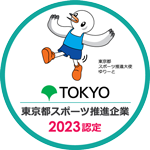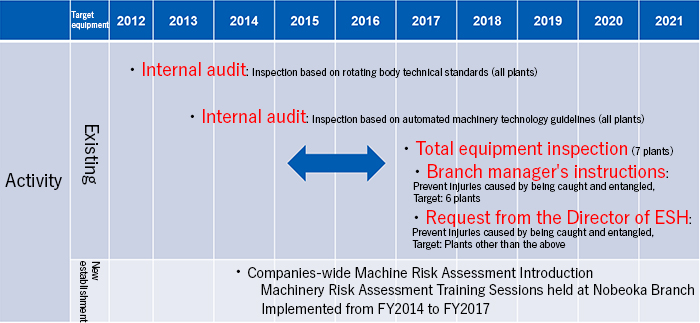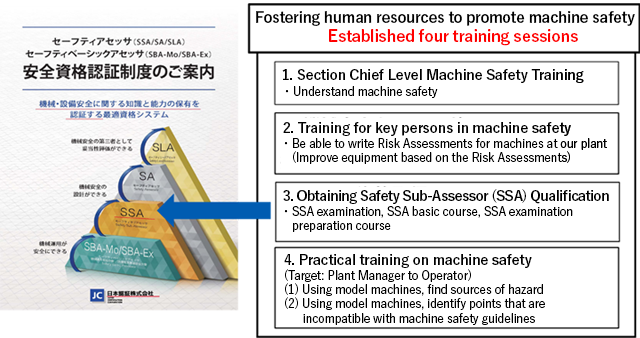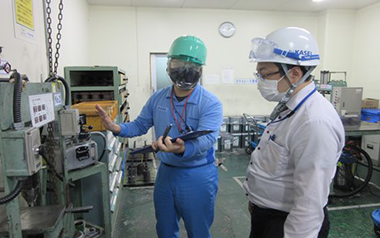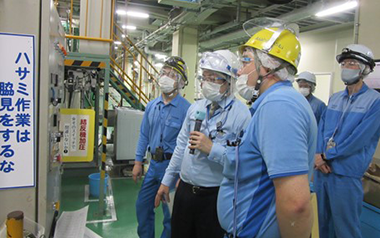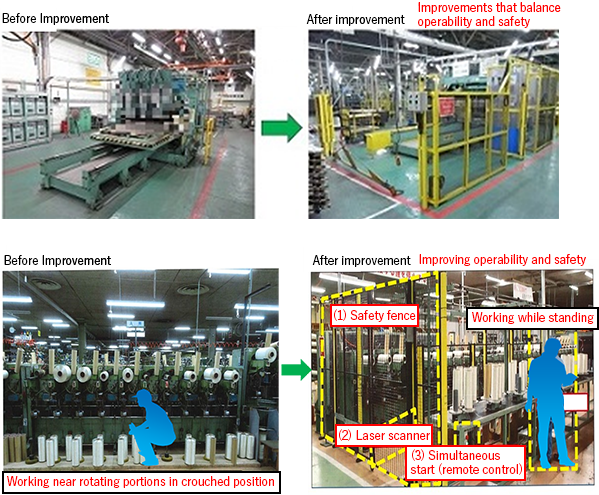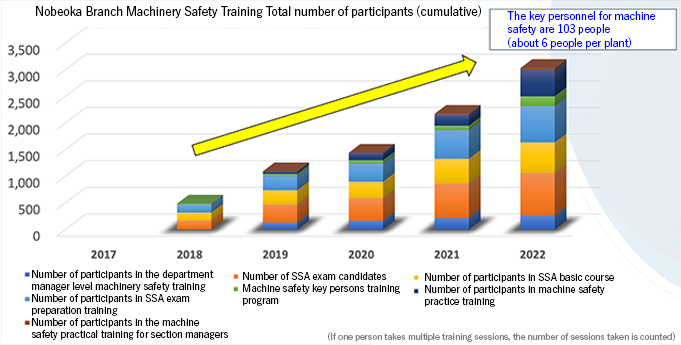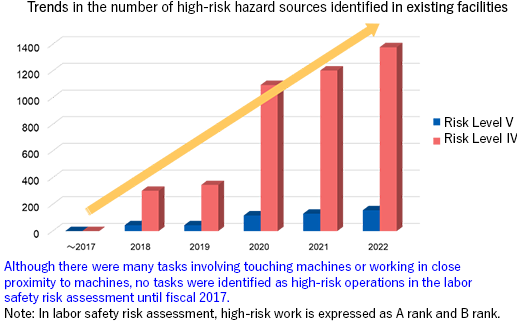Health & Productivity Management and Occupational Health & Safety
Policy
While business is operated globally, the structure of society is changing dramatically. The population continues to age, and the way of hiring people as well as working styles are changing in various ways. In this time of change, it's necessary to ensure a comfortable and safe workplace environment for all employees and enable them to make the most of their capabilities and possibilities.
The Asahi Kasei Group regards employees as our most important asset. In terms of maintaining health and safety at our workplaces and work sites, our ESH & QA Principles state: "the Asahi Kasei Group gives the utmost consideration to health maintenance, operational safety, occupational health and safety, quality assurance, and environmental protection throughout the product lifecycle from R&D to disposal as preeminent management tasks in all operations." Under this policy, we work in cooperation with the Labor-Management Council and the Health & Safety Committee to create a comfortable workplace environment throughout the company.
Preventive action for occupational accidents
In fiscal 2020, the Asahi Kasei Group established a Life Saving Actions (LSA) program to eradicate serious occupational accidents, and we began implementing it throughout the Group. We have established the following four behaviors as prohibited behaviors that could result in loss of life if not observed, and are promoting thorough adherence to these behaviors in all aspects of our business activities.
 The four behaviors prohibited by LSA
The four behaviors prohibited by LSA
In addition, our ongoing efforts to prevent occupational accidents is integrated into our comprehensive OHSMS2 program that combines conventional health and safety initiatives1 with risk assessments and a prevention-oriented plan-do-check-act (PDCA) system.
- 1
Conventional health and safety initiatives:
Tidiness/orderliness/cleanliness (3S), reporting of near-accidents and potential hazards, hazard prediction analysis, safety patrols, and case studies - 2
Occupational Health and Safety Management System:
A standardized management system used to confirm that continuous improvement is being applied to measures to minimize the risks of workplace injuries and to prevent the emergence of future risks
Approach to prevent occupational accidents
1. Identification of potential hazards
Effective prevention of occupational accidents requires the identification of all potential hazards in a workplace. In addition to conventional health and safety initiatives, it is important to think of potential issues and consider safety from the perspective of the problems which conceivably arise in a wide variety of situations—as a result of both potentially unsafe physical conditions (hazardous working environment due to equipment, materials, noise, etc.) and potentially unsafe work actions of personnel.
2. Risk assessment
Priority for mitigating the potential workplace hazards identified is assigned based on a scoring system that combines the severity of the impact of problems which could occur and the frequency with which such problems would be likely to occur. We implement mitigation measures starting with significant risks with the highest risk scores.
3. Mitigation of the highest risks
Measures to achieve inherent safety by eliminating unsafe conditions (by eliminating dangerous procedures, automation, eliminating sources of problems, changeover to safe materials, etc.) and the application of safeguards are extremely effective in the effort to avoid risks.
We focus on achieving inherent safety and applying safeguards (isolation and stoppage) to avoid risks associated with the use of machinery and equipment to prevent the “caught in/between machinery” category of accident, which can easily result in particularly severe injury.
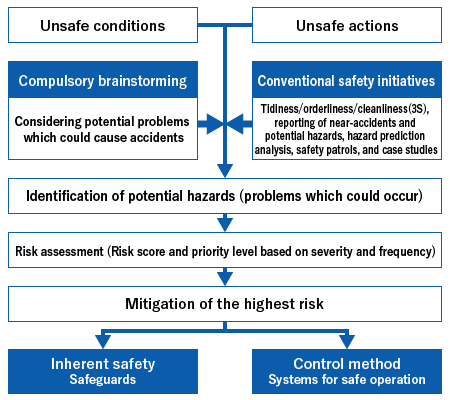 Schematic image for prevention of occupational accidents
Schematic image for prevention of occupational accidents
Inherent safety and safeguards
Measures to achieve inherent safety and the application of safeguards to avoid risks are generally considered to provide the greatest level of safety, as shown in the following table. We incorporate such measures in the construction of new or replacement facilities, upon safety reviews of existing facilities, and to prevent the recurrence of accidents.
Systems for safe operation
Our group is striving to ensure safety in our activities to comply with safe operating standards*. Specifically, we are devising and implementing measures such as checking the status of compliance with safe operating standards in our daily operations. Operations for which the elimination of risk through equipment modification is impractical are classified as operations requiring special control and strictly managed, such as by ensuring worker competence and prior plan-based approval.
- *safe operating standards
Rather than individual rules for specific procedures, safe operating standards are a system of safety principles which define common safety practices that apply to categories of operation based on similarity of risk. For example, to prevent entanglement in machinery, our standard stipulates not to touch any exposed moving parts.
Sharing and utilizing information of occupational accidents
We investigate causes and take measures to prevent recurrence at sites where occupational accidents occur. We share a database of information on all occupational accidents within the Asahi Kasei Group for utilization in activities such as safety training, case study discussions, and prevention of similar accidents.
Occupational accident statistics
In fiscal 2023, 20 lost-worktime injuries occurred among Asahi Kasei Group employees in Japan. We will continue to engage in safety initiatives through our LSA program to prevent the occurrence of serious accidents in the future.
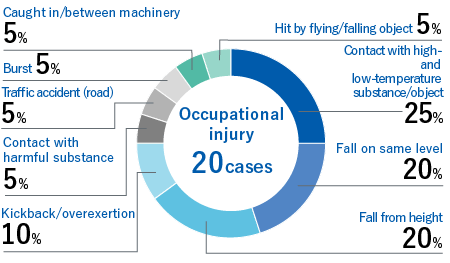 Incidence of lost-workday injury by event category (FY2023 in Japan)
Incidence of lost-workday injury by event category (FY2023 in Japan)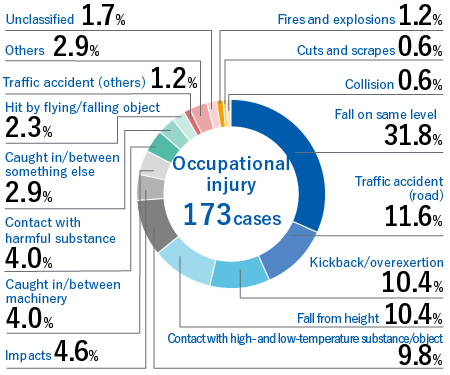 Incidence of lost-workday injury by event category (FY2014–2023 in Japan)
Incidence of lost-workday injury by event category (FY2014–2023 in Japan)
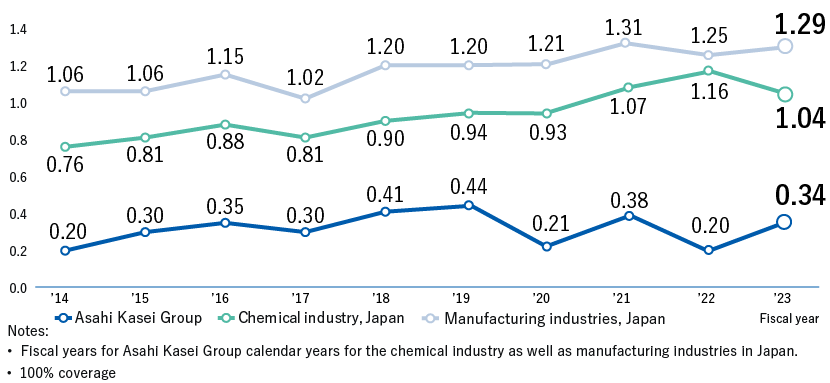 Group Lost Time Frequency Rate (%)1
Group Lost Time Frequency Rate (%)1
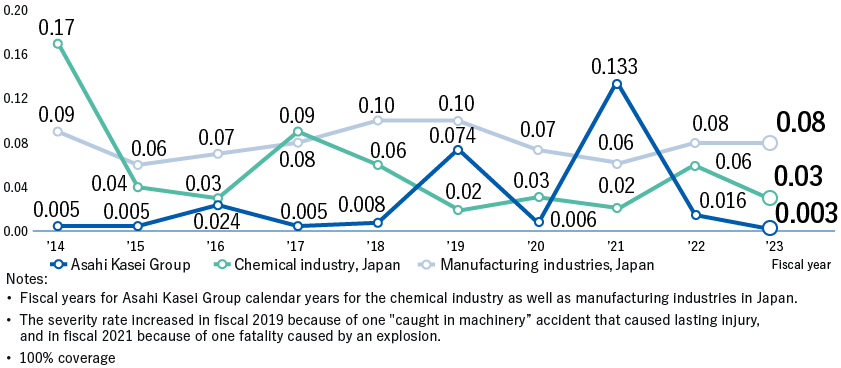 Group Severity Rate (%)2
Group Severity Rate (%)2
- 1Lost Time Frequency Rate:
A safety indicator showing the rate of occupational accidents and calculated by the following formula. [Lost time frequency rate = number of victims of lost time injuries ÷ total working hours × 1,000,000 hours]
Our goal of 0.1 or less is extremely ambitious. At a plant with 100 workers, it would mean only one worker in 50 years suffered from an occupational injury which resulted in a day off. - 2Severity rate:
Lost workdays, severity-weighted, per thousand man-hours worked.
Maintaining and improving comfortable workplaces
Workplaces where potential health hazards are present are subject to regular monitoring under the Working Environment Measurement Law. Additionally, we will manage risks for chemicals to identify and reduce risks resulting from chemical substances.
With an amendment to Japan's Industrial Safety and Health Act in May 2022, there have been major changes, including the requirement for businesses to autonomously manage chemical substances. The Asahi Kasei Group is implementing appropriate measures in response. In FY2023, we held company workshops to foster chemical substance managers who are now required to be appointed at workplaces manufacturing risk-assessed substances, and trained 329 chemical substance managers internally.
Noise and heat exposure data are recorded and maintained for all relevant personnel to enable each individual's exposure to be managed and minimized. We are advancing plant modification and reviewing work procedures to create a more comfortable work environment.
Machine Safety Activities at the Nobeoka Branch
1. Significance of the initiatives
Over the past ten years at the Nobeoka Branch, we have conducted internal audits, equipment inspections, and issued directives with the goal of eradicating occupational accidents in which workers are caught or entangled in machinery; however, we have not been able to eradicate such incidents.
2. Specific initiatives
We reviewed our past activities and have launched two initiatives at our six processing and assembly plants.
- 1)Creation of four training programs to develop human resources capable of correct machinery risk assessments
- 2)Introduction of machinery risk assessments for existing facilities
Collaboration with internal and external specialists
3. Training for key persons in machine safety
The purpose of this training is not training for training's sake, but to complete a machinery risk assessment sheet on equipment actually used in production and to include it in steps leading to actual improvement of the equipment. We select participants from among Safety Sub-Assessor qualification holders, and bring in specialist instructors.
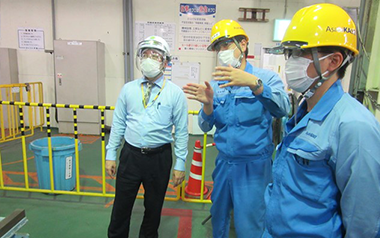 Machine Safety Key Persons Training Program
Machine Safety Key Persons Training Program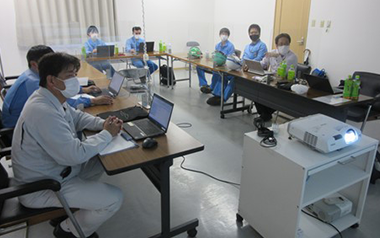
- Members of the manufacturing section, who are familiar with how to use and work with the equipment, and members of the equipment technology section, who are familiar with the equipment specifications, are selected in pairs from among the Safety Sub-Assessor qualification holders at each plant.
- A unique feature of this program is that, rather than desk-based, instructors who are specialists in machine safety instruct the trainees directly while observing the equipment on site, based on the "Three Actuals" principle. The training period is approximately 5 months long to complete the risk assessment of actual machinery and equipment.
4. Practical training on machine safety
The purpose of this training is to be able to find sources of hazard in on-site equipment and to be able to point out non-conformance in on-site equipment. Eligible participants are all levels of employees, including plant managers.
This training plays an important role in moving the entire plant toward how it should be. A total of 10 instructors, mainly from the Machinery Systems Technology Department, conduct the training.
A unique feature of this training is that exercises are conducted using model machines that actually move. This facility was designed by the Machine Systems Technology Department by incorporating non-conforming parts of production equipment at various plants of the Nobeoka Branch.
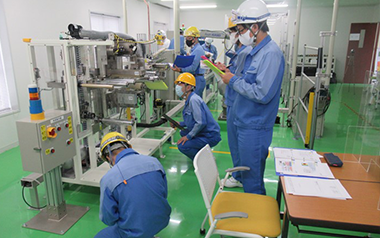 Practical training on machine safety
Practical training on machine safety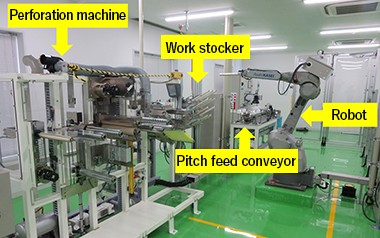 Model machines used in safety training
Model machines used in safety training
Participants are able to practice on model machines having many hazards, and take what they understand from the training back to their work sites to use for improvement.
5. Track record of machine safety activities at existing facilities
High-risk hazard sources identified by key persons are being improved at each plant, considering both operability and safety.
Rather than simply shielding off hazards, some plants have been thinking earnestly about how to ensure that all workers can work safely, even going so far as to change tried and tested work methods, and we believe that machine safety is now accepted by workers on the factory floor.
6. Results
- Human resource development
Through these activities, we have trained a total of approximately 3,000 people. Of these, there are now over 100 key persons who can write machine risk assessments.
- Identification of Hazard Sources
Trained personnel correctly performed machine risk assessments and identified approximately 1,500 high-risk hazard sources.
- Equipment Improvements
Each plant has implemented risk reduction measures for identified hazard sources and has completed approximately 63% of equipment improvements.
However, there are still many plants where improvements are difficult and tests are continuing, as no way has been found to maintain production with safety equipment installed. Such facilities will continue to be operated with special controls until suitable technology is established.We implemented this activity at 10 plants as a second phase begun in fiscal 2021, and expanded to two plants in the third phase begun in fiscal 2024, with the entire Nobeoka Branch working together to promote the activity.
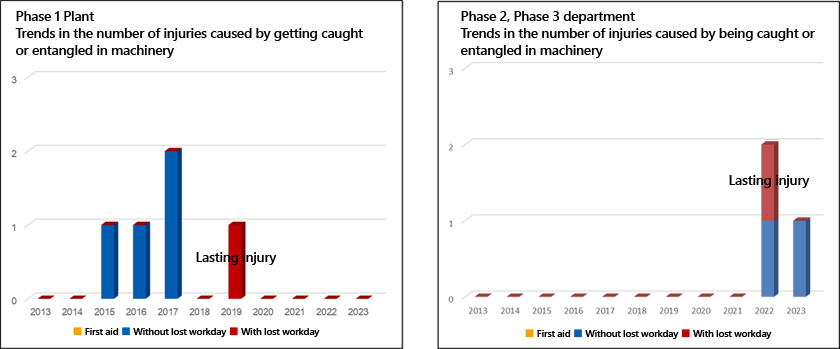
7. Conclusion
In phase one, we had occupational accidents in which workers were caught or entangled in machinery happening almost every year until fiscal 2019, with none occurring since fiscal 2020. However, there are still risks in phase two, as there have been subsequent occupational injuries at facilities that have not conducted machine risk assessments in fiscal 2022. We will continue this activity through both human resource development and the creation of safe facilities.
Health & Productivity Management Policy
Human resources are the essential element for the improvement of corporate value. Providing an environment that supports the physical and mental well-being of employees is becoming increasingly crucial for corporations.
Therefore, we have developed existing Environment, Safety, Health, and Quality Assurance activities, positioning health-related initiatives as a company-wide management issue, and in October 2020, we published the Asahi Kasei Group’s “Statement on Management for Health.” Therefore, we will work to further promote health and productivity management* based on the Asahi Kasei Group Health and Productivity Management Vision described in the Statement.
We will further enhance our programs for the prevention of mental health issues, which is a priority in our PDCA cycle, as defined in the health and productivity management goals of our medium-term plan. In 2022, we adopted the 'percentage of employees absent from work due to mental health issues' as an indicator for the director's remuneration policy to measure the progress. Moreover, we set health management goals for management issues that need to be resolved in promoting health and productivity management, and pursue physical and mental health through the effectiveness of health management measures and a real sense of performance improvement. The next step is the promotion of well-being management, which aims to create a state of physical, mental, and social well-being for our employees.
- * In Japanese “Kenkokeiei” is a registered trademark of Nonprofit Organization Kenkokeiei.
Statement on Management for Health
The Asahi Kasei Group pursues sustainable growth of corporate value while contributing to the achievement of a sustainable society by leveraging its strengths of diversity and the capability to change. We believe that human resources are the key to achieving this goal.
In the future, it will become ever more important for the company to create an environment where employees can both physically and mentally healthy and where everyone can play an active role. We hereby declare that we will work to promote health and productivity management, which further refines the initiatives for promoting and maintaining health we have developed to date, under our Group Health and Productivity Management Vision.
October 2020, Asahi Kasei Corp.
The Asahi Kasei Group Health & Productivity Management Vision
Health and Productivity Management Vision
The Asahi Kasei Group will contribute to the achievement of a sustainable society by encouraging the active participation and growth of each individual and the improvement and development of Group productivity. To this end, the company will ensure that its employees and their families are both physically and mentally healthy, and strive to enhance their job and life satisfaction.
Behavioral Guidelines
- 1. The company will work in tandem with health insurance companies and labor unions, to not only continuously support individual workers, but also engage in various activities, including workplace activities, that maintain and promote environmental improvement for the entire Asahi Kasei Group, and the good health of families that support employees.
- 2. It’s also important for each individual to be aware that they are responsible for their own health, in order to enrich their own lives, and we provide support to help them achieve this.
Immediate goals (what we want to achieve) and activities
For the success and growth of talented personnel and the increased and enhanced productivity of the Asahi Kasei Group, and in addition to our current work on reducing (1) mental health problems, (2) lifestyle-related illnesses and metabolic syndrome, and (3) cancer, we will implement various measures and activities to improve employees’ work engagement and to maintain and promote health as a basis for preventing the above health conditions.
Promotion framework for health & productivity management
In January 2020, we established the Health and Productivity Management Promotion Office, and in April 2021, our nine Health Management Centers in Japan became affiliated with the head office. This enabled us to standardize and optimize overall health-related operations, improve coordination among different sites, and promptly address group-wide challenges, with unified promotion of health and productivity management. Furthermore, we started Health and Productivity Management at our small-scale establishments and affiliated companies in Japan from April 2022.
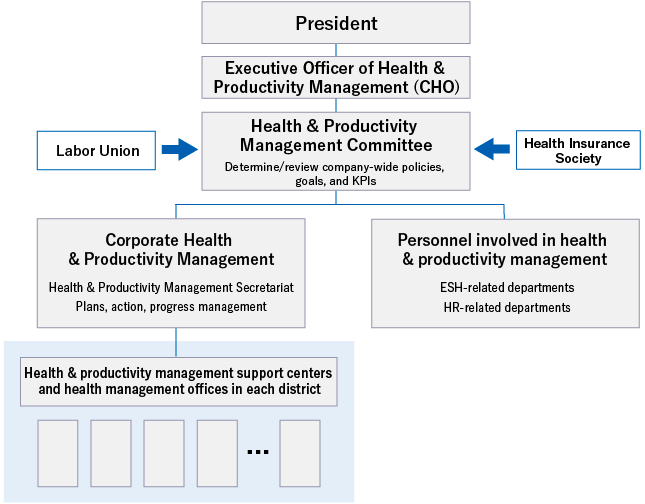 Promotion framework for health & productivity management
Promotion framework for health & productivity management
Purpose of health & productivity management
We aim for a mutually reinforcing cycle of sustainability consisting of contribution to a sustainable society and sustainable enhancement of corporate value, by creating a synergy among the success and growth of each individual, enhanced job satisfaction and motivation, and a strong and vibrant organizational culture, which will lead to the realization of employee well-being and the increased and enhanced productivity of the Asahi Kasei Group.
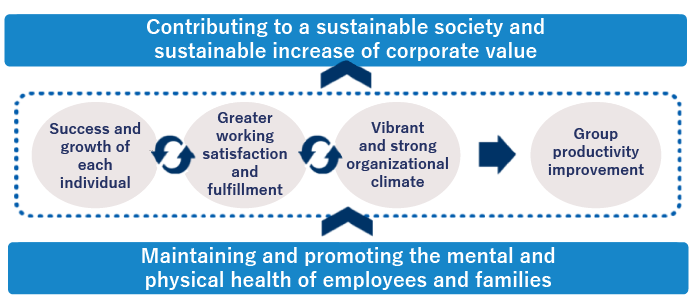 Overview of health & productivity management
Overview of health & productivity management
Health & Productivity Management Strategy Map
In promoting health & productivity management, we pursue thorough understanding the expected outcomes of our investments and measures along with how our initiatives translate into concrete actions to address the issues we aim to resolve. We have charted these relationships on a diagram.
Health & Productivity Management Targets (Priority Measures)
To achieve our health and productivity management targets, we believe it is important both to create opportunities for employees to be active and grow, and to revitalize individuals and organizations.
To create opportunities for employees to be active and grow, we will reduce the number of days employees take off work. In addition to this, we will work on revitalizing individuals and organizations.
From the perspective of improving productivity, we will also strive to help employees get more and better-quality sleep, a lack of which is said to be a major contributing factor behind “presenteeism.”
For this reason, the Group has set its primary health and productivity management goals as follows: (1) creation of opportunities for employees to play an active role and grow, etc. (improving the absence rate through countermeasures for mental health issues, people with serious lifestyle-related diseases, people with metabolic syndrome, cancer, and smoking), (2) revitalizing individuals and organizations (improving work engagement), and (3) improving the quality and quantity of sleep.
(1) Creating opportunities for employees to play an active role and grow, etc. (improving the absence rate)
| Item | FY2019 Results |
FY2020 Results |
FY2021 Results |
FY2022 Results |
FY2023 Results |
FY2024 Target3 |
|---|---|---|---|---|---|---|
| Percentage of employees absent from work due to mental health Issues1 | 0.91 | 0.98 | 1.00 | 1.07 | 1.16 | 0.64 |
| Percentage of employees seriously ill with lifestyle-related diseases2 | 11.0 | 11.0 | 10.7 | 10.7 | 9.9 | 7.7 |
| Percentage of employees suffering from metabolic syndrome | 11.1 | 11.4 | 11.1 | 10.7 | 10.8 | 7.8 |
| Number of days off per cancer case | 79.2 | 68.1 | 87.5 | 88.6 | 67.3 | 67.3 |
| Smoking rate (%) | 25.8 | 24.7 | 23.5 | 22.5 | 21.8 | 15.5 |
- 1Percentage of employees who are absent from work for 30 or more consecutive days during the fiscal year
- 2Selected based on in-house criteria
- 3Medium-term target as of 2020
(2) Revitalizing individuals and organizations (improving work engagement)
The Asahi Kasei Group conducts annual stress checks in July to promote awareness among employees of their own stress levels, with the aim of primary prevention to reduce the risk of mental health problems. In fiscal 2020, we also adopted the KSA (vitality and growth assessment) survey, which enables more detailed analysis and visualization of work engagement (enthusiasm, immersion, and vitality) in workplaces. KSA quantitatively visualizes workplace conditions according to three indicators: (1) supervisor–subordinate relationships and workplace environment, (2) vitality, and (3) actions leading to growth.
Each workplace is currently striving to improve work engagement by combining the results of the stress check and KSA analysis to visualize management and other initiatives implemented, and to have employees at each workplace engage in dialogue with each other.
(3) Improving the quality and quantity of sleep
Next to mental health issues, the quality and quantity of sleep is considered to be a major cause of presenteeism, so we will promote countermeasures to address this problem.
Specifically, we will (1) establish a method for evaluating sleep, (2) investigate ways to handle employees who are not getting enough sleep, and (3) promote education and training to improve sleep literacy.
In addition, starting in fiscal 2022, reducing the percentage of employees who do not get enough rest from sleep has been newly established as a KPI for sleep as part of our Health and Productivity Management Targets.
| Item | FY2019 Results |
FY2020 Results |
FY2021 Results |
FY2022 Results |
FY2023 Results |
FY2024 Target* |
|---|---|---|---|---|---|---|
| Sleep KPI (%) | 32.4 | 28.5 | 27.2 | 28.0 | 28.5 | 22.7 |
- *Medium-term target as of 2020
Specific initiatives
Mental health and care
The Asahi Kasei Group is working to reduce the rate of employees missing work due to mental health issues by enhancing its four complimentary approaches to care in accordance with its mental health care guidelines.
(1) Self-care
To promote understanding of stress and how to cope with mental health-related issues, we have been implementing and improving the training on mental health. Since 2023, we have provided mental health self-care training annually to all 30,000 Group employees to help them recognize and manage their own stress and mental health issues at an early stage.
(2) Line care
As part of the line-based care, we use the results of organizational analysis of stress checks and training courses to improve the work environment. The Suzuka district is working to create a comfortable workplace, and thanks to the 15-years of ongoing efforts, the percentage of employees absent from work due to mental health issues has been decreasing. Since FY2020, we have been offering workshops in the Mizushima area in collaboration with the HR department, occupational health staff, and the labor unions, using the stress check and KSA results in an integrated manner.
(3) Care provided by occupational health staff and others
We conduct stress surveys on individuals using stress checks and have our occupational health staff follow up with them.
We have conducted a program called “Follow-up Care for Transferred Employees,” in which we monitored how they were adjusting to new environments and workplaces.
We conduct the follow-up via questionnaires and interviews in which transferred employees confirm their health status and how they have adapted to their new roles and living environment, and make early intervention. The results are fed back to workplaces as necessary to support the creation of workplaces that prevent the onset of mental illness.
(4) Care provided by specialized organizations
Rework programs are also available for those who took a leave of absence due to mental health issues, as part of the rework trial designed to help them resume their roles successfully. In addition, we provide care by specialists, including training sessions by external lecturers and referral of counseling services.
(5) Analysis of direct factors and circumstances resulting in leave of absence for mental health
To reduce the number of employees on sick leave due to mental health issues, we have our occupational health staff analyze the causes of these absences on a district-by-district basis. They determine contributing factors by considering both direct causes and background information obtained from interviews. Results from each site are also aggregated, with company-wide data analyzed according to various aspects such as job category and position, which are then shared throughout the company, and for which countermeasures are created.
Initiatives for employees with severe lifestyle-related diseases and metabolic syndrome
In order to maintain and improve the health of our employees, the Asahi Kasei Group is working to prevent and address lifestyle-related diseases.
(1) Specific health guidance and Get Fit Challenge
Our company-wide policy on specific health guidance is that, in principle, employees must attend a consultation unless they have a valid reason not to, and may also receive the guidance during work hours.
We have also expanded the program’s scope with the “Get Fit Challenge” to include previously ineligible employees, which has helped to prevent lifestyle-related diseases from an early stage.
(2) Creation of exercise occasions
Each production site organizes walking events, as well as annual physical fitness tests to monitor the changes over time. Also, exercise videos that are easy for anyone to do anywhere are available on an internal website to encourage employees to start exercising.
Actions to promote exercise habits at each site
To prevent the development of serious lifestyle-related diseases and metabolic syndrome, we host walking events and physical fitness tests at each production site as part of our efforts to promote regular exercise.
Utilizing a walking app, we encourage participants to change their behavior, raise health awareness, and foster communication, even in remote work settings. In some districts, we hold a “Mystery and Health Walk” as a recreational activity, with a quiz rally where participants search for quizzes walking within the manufacturing site's premises, with the intention of increasing the number of steps while having fun.
Creation of exercise videos to establish exercise habits
We have created videos of simple exercises that can be easily done at home, at one’s desk, etc., and posted them on an internal website.
The Asahi Kasei Judo Club and Office District Health Management collaborated to create a simple stretching video that can be followed during office hours to refresh employees who work continuously at their desks, and to help them establish exercise habits. Menus devised by judo club physical maintenance professionals have been edited into short videos for use in both a personal capacity and in the workplace.
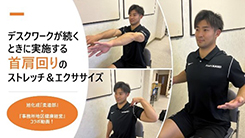 Stretching video created by Asahi Kasei Judo Club
Stretching video created by Asahi Kasei Judo Club
(3) Occupational health staff visualize the physical and mental state of employees at each workplace as a group and report to the department heads
In the Nobeoka and Fuji regions, which are major manufacturing sites of the Asahi Kasei Group, the results of health checkups, lifestyle data, and sickness and injury leave data are analyzed by workplace, and the occupational health staff report the results of the group analysis to the head of each workplace. This allows those overseeing each workplace to gain an objective understanding of the physical and mental state of their employees as a group, identify issues, and take measures to improve the situation.
Cancer awareness initiatives
(1) Education to improve cancer literacy
We provided a company-wide e-learning program to all employees, focusing on cancer prevention and promotion of a better work-life balance. The program aimed to educate employees about cancer, promote healthier lifestyles that can reduce the risks of cancer, and encourage regular cancer screenings for early detection and treatment.
We also had a gynecologist from Cancer Institute Hospital give a lecture on “Women's Cancers” as part of our health measures for women, and the video was posted on the company website.
(2) Recommendation for cancer screening
We encourage cancer screening during regular health checkups or physical exams, with some of the expenses covered. We also make sure our employees are familiar with our support programs for those who undergo cancer treatment and return to work after their leave.
Efforts to Reduce the Smoking Rate
We plan to implement a total ban on smoking during working hours from April 2024, and then to ban smoking completely on company premises and during banquets* from April 2025. This is in line with the Asahi Kasei Group No-smoking Policy, whose basic concept is supporting smokers to quit smoking and protecting employees from unwanted passive smoking.
Besides the Smoking Cessation Challenge organized and implemented by the Asahi Kasei Health Insurance Society, we will provide a variety of quit smoking programs and seminars to help smokers refrain from smoking.
- *No smoking during banquets: Those who leave the dining area to smoke are not permitted to re-enter.
Launch of the sleep program and its trial
A few years ago, we launched a project to establish sleep strategies, as after mental health issues, the quality and quantity of sleep is considered to be a major cause of presenteeism.
As a result, an improvement can be seen in the KPI “Percentage of those who get insufficient rest from sleep”, which is one of our Health and Productivity Management Targets.
For our Sleep Strategies Project, we began a trial run of the Sleep Improvement Program in 2021 and continued the program for three more years, as 80% of participants recognized that their sleep had improved due to the program.
We intend to further strengthen sleep strategies at manufacturing sites in the future, as they are proving to be effective at our administrative sites in Tokyo and Osaka where there is a lot of office work.
We recognize that sleep strategies are particularly challenging for shift workers, and plan to create videos to introduce them into their training curriculum by the end of fiscal 2024.
Preparations are underway to expand the sleep survey to districts in which trials were previously conducted, and to roll out the survey company-wide from fiscal 2025
Education on Health & Productivity Management
To support employees in acquiring knowledge and skills for health and productivity management, we provide a number of training programs based on the job roles for the various employee ranks.
| Training | Method of Training | Purpose | FY2023 Number of trainees |
|
|---|---|---|---|---|
| Training by job level | New hire training | e-learning Face-to-face training |
Understand the basic health concepts as a responsible member of society, commit to physical and mental self-conditioning, precautions for handling hazardous materials, and necessary company rules, etc. | 203 people |
| Training for new managers | e-learning | Basic concept of work and health, company and employee obligations in health management. | 321 people | |
| Training for newly appointed top management | e-learning | Health management services, including hazardous work and occupational disease prevention necessary for on-site management, understanding of the Asahi Kasei Group’s overall health and productivity management, and its importance. | 316 people | |
| Department Head Environment, Safety, Health Training | Online | Management of hazardous materials handling operations at manufacturing sites. | 91 people | |
| Training by Subject | e-learning | ・Mental Health Care ・Cancer Prevention and Compatible Support ・Anti-smoking Measures |
27,597 people (95.4%*) 27,336 people (95.7%*) 24,839 people (94.1%*) |
- *Percentage of participants who are eligible for the training (%)
Addressing Global Health Challenges
Health Management Support for Overseas Employees
The Asahi Kasei Group is strengthening health management of our employees working overseas, who are increasing in number as our business expands globally.
We provide pre-transfer medical checkups, vaccinations, advance Tamiflu prescriptions (anti-influenza medication) in case of a new influenza pandemic, and pre-transfer health education, as well as annual medical checkups throughout employees’ assignments and a post-transfer medical checkup upon their return.
During an assignment, a web interview with an industrial physician is conducted. In addition to the stress check conducted in Japan, we use a health survey form to assess symptoms, local lifestyles, mental and physical health, and vaccination status. Based on the questionnaire results and medical exams, we schedule online interviews with our occupational physician or health advisor as required.
Moreover, for employees working overseas who are suspected of working long hours, online interviews with industrial physicians are conducted based on the questionnaire results.
“Health Letter from Tokyo” is regularly distributed to expatriates as well, providing information such as health checkup results and lifestyle questionnaires, and health information, all compiled by region. We also provide health counseling for other health concerns and problems.
Activity evaluation and recognition by external organizations
To gain an objective understanding of the Asahi Kasei Group’s health and productivity management efforts and further improve our activities, we had the following external organizations evaluate our initiatives.
Recognized as White 500 (large enterprise category) in the Certified Health and Productivity Management Organization Recognition Program 2025
We were recognized as one of the “White 500” organizations under the Certified Health and Productivity Management Organization Recognition Program (Large Corporation Category) of 2025, jointly operated by the Ministry of Economy, Trade and Industry (METI), and Nippon Kenko Kaigi. The Certified Health and Productivity Management Organization Recognition Program acknowledges corporations for their exceptional health and productivity management practices, aligned with community health agendas and health promotion activities advocated by the Nippon Kenko Kaigi.

Received the Gold Prize in the Cancer Ally Awards 2024
We received the Gold Prize in the 2024 Cancer Ally Awards, sponsored by a non-governmental organization dedicated to addressing cancer and issues of those who are receiving cancer treatment while continuing their career. This project aims to create a society and workplace environment that empowers cancer patients to maximize their potential while undergoing treatment.
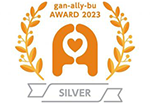
Certified as a Sports Yell Company of 2025
We have been certified as a Sports Yell Company of 2025 by the Japan Sports Agency. This program aims to encourage the involvement of prime-age workers in sports and generate a societal interest in physical activities. It will grant certification to companies that actively promote sports to improve their employees’ health. We were recognized for our efforts in providing exercise videos, athletic facilities, and walking events held at each of our sites.
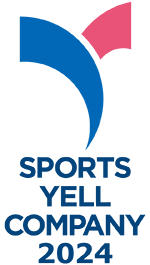
Recognized as Tokyo Sports Promotion Company 2024
We were recognized as a “Tokyo Sports Promotion Company” by the Tokyo Metropolitan Government. This program recognizes companies that encourage their employees’ sports activities and contribute to society in the field of sports. We were recognized for our efforts in raising employees’ health awareness through walking events and seminars held at each production site.
